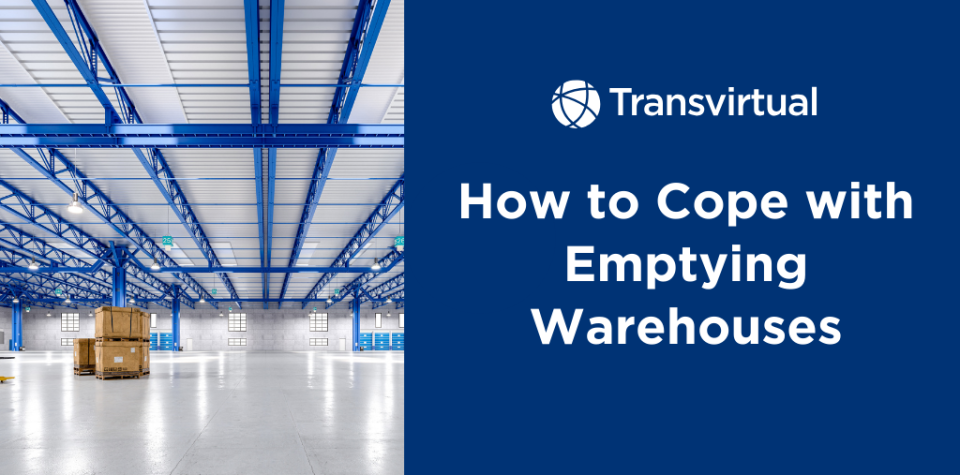Table of Contents
The US supply chain industry is faced with yet another challenge: surging warehouse vacancies. According to market data, there was a reported 7.1% vacancy rate in warehouses in Q2, the highest rate since 2014. This is after the necessary expansions to meet inventory demands during the pandemic. In order to cope, 225 million square feet of warehouse space is on sublease, which is a significant 25% increase from the previous year.
But while the headlines point to uncertainty, warehouse operators still have options. Let’s look at practical strategies to help warehouse operators thrive, especially when occupancy dips.
What Happens When Warehouses Are Empty
When warehouses sit empty, the impact stretches far beyond vacant floor space.
Fixed costs
Rent or mortgage, utilities, insurance, and maintenance remain the same whether the warehouse is full or half-empty. In fact, rental rates have increased to $10.12 per square foot. These ongoing expenses become harder to cover when revenue goes down.
Underutilized capacity
Empty aisles and unused racking represent wasted potential. Space that isn’t optimized creates inefficiencies, making it harder to justify the original investment in infrastructure. This underuse can also limit flexibility when demand eventually picks up.
Labor challenges
With less inventory to manage, staff may not be working at full capacity. Some operators face the tough choice of reducing headcount, while others struggle to keep employees engaged during slower periods.
Pricing pressure
On the commercial side, property owners may have to offer reduced rates, flexible lease terms, or costly incentives to attract or retain tenants. This affects their profitability.
Ways Smart Operators Are Coping with Emptying Warehouses
While the rise in vacancies may feel like a setback, it also gives warehouse operators a chance to re-evaluate their operations. Here are effective approaches to keep your facilities productive and financially sustainable.
Flexible and scalable storage
One of the smartest ways operators are responding to empty warehouses is by rethinking how space is designed and leased. Instead of sticking with rigid layouts that only work for one type of operation, many are shifting toward modular, scalable designs. This allows them to repurpose sections of a warehouse for different uses without costly overhauls.
At the same time, landlords and 3PLs are offering more flexible lease terms, including smaller spaces and shorter contracts, so businesses can scale up or down as demand changes. Prices vary according to size, with smaller warehouses costing $9.51 per square foot annually and larger ones costing $7.26 per square foot.
This flexibility helps reduce wasted overhead, keeps facilities productive, and makes it easier for operators to stay agile in a market where conditions can shift quickly.
Alternative revenue streams
When warehouses sit empty, smart operators look for new ways to generate revenue. One approach is co-storage or shared space, where multiple businesses use the same facility to reduce costs and improve efficiency. Others are turning to cross-docking, keeping goods moving without tying up floor space.
Beyond traditional logistics, some operators are leasing to non-traditional users, like retailers running pop-up stores, or e-commerce brands setting up urban micro-fulfillment hubs to speed up delivery. Even last-mile providers are stepping in, using empty warehouses as mini-distribution centers. These creative strategies transform underused space into a valuable, income-generating resource.
Inventory management strategies
Smart operators know that when warehouses are sitting half-empty, it’s the perfect time to sharpen inventory management strategies. Instead of overstocking, many are shifting to “just-in-time” or “just-enough” restocking, ordering only what’s needed to keep supply moving without tying up cash in unused goods.
At the same time, regular inventory clean-ups are helping clear out slow-moving or obsolete stock through markdowns, bundle deals, or promotions. This not only frees up space but also boosts cash flow and reduces carrying costs. Keeping stock lean and active lets operators maintain healthier margins and ensure warehouses remain efficient and responsive to demand.
Tech and Data Analytics
Technology is giving warehouse operators the visibility they need to stay ahead. Predictive analytics and AI-driven forecasting equip businesses to better anticipate demand and avoid costly restocking mistakes. Instead of relying on guesswork, operators gain insights into seasonal trends, customer behavior, and supply fluctuations.
Alongside forecasting, real-time inventory tracking tools are becoming essential. Digital dashboards provide instant updates on stock levels, helping teams spot issues early and make faster decisions. Together, these tools create smarter, data-driven warehouses that use information to stay efficient, resilient, and ready to meet changing customer needs.
Flexible labor and operation strategies
When warehouse volumes dip, smart operators make their labor and operations strategies more flexible. Cross-training staff ensures workers can handle multiple roles, keeping productivity steady even with smaller teams. Many are also using flexible staffing models, like part-time or temporary workers, to adjust labor costs in line with demand.
At the same time, efficiency gains come from adopting lean practices and cutting out wasted steps in workflows with software solutions like a Warehouse Management System. Tools and insights highlight how streamlined processes reduce overhead while boosting performance. The result is a workforce and operation that stay agile, cost-effective, and ready to scale when demand shifts.
From Empty to Efficient Warehouses
Empty warehouses aren’t just the result of bad luck. They’re a clear sign of bigger shifts in demand, consumer behavior, and supply chain dynamics. While that can feel like a setback, it’s also an opportunity for operators to rethink how they use space, people, and technology. The smartest responses we’ve seen involve using data, adopting flexible layouts and staffing, and finding creative ways to turn unused capacity into value.
You don’t have to transform everything overnight. Start by assessing your current setup, then pick one or two changes that can deliver quick wins and build resilience over time. That’s where tools like Transvirtual come in, helping you track inventory in real time, streamline operations, and adapt faster to changing conditions. The challenge is real, but so is the opportunity.


